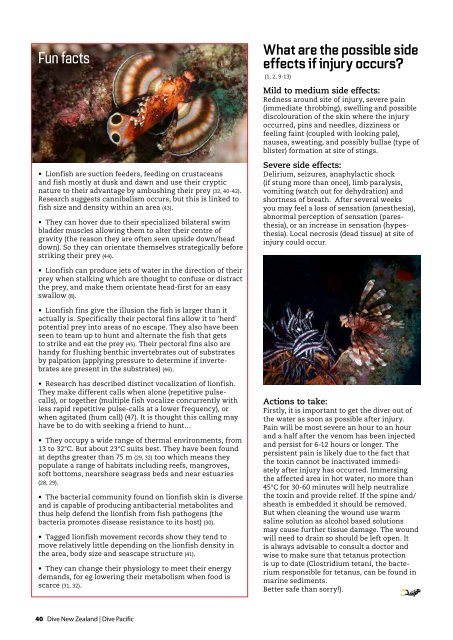Dive Pacific 171 Oct- Nov 2019
Create successful ePaper yourself
Turn your PDF publications into a flip-book with our unique Google optimized e-Paper software.
Fun facts<br />
What are the possible side<br />
effects if injury occurs?<br />
(1, 2, 9-13)<br />
Mild to medium side effects:<br />
Redness around site of injury, severe pain<br />
(immediate throbbing), swelling and possible<br />
discolouration of the skin where the injury<br />
occurred, pins and needles, dizziness or<br />
feeling faint (coupled with looking pale),<br />
nausea, sweating, and possibly bullae (type of<br />
blister) formation at site of stings.<br />
• Lionfish are suction feeders, feeding on crustaceans<br />
and fish mostly at dusk and dawn and use their cryptic<br />
nature to their advantage by ambushing their prey (32, 40-42).<br />
Research suggests cannibalism occurs, but this is linked to<br />
fish size and density within an area (43).<br />
• They can hover due to their specialized bilateral swim<br />
bladder muscles allowing them to alter their centre of<br />
gravity (the reason they are often seen upside down/head<br />
down). So they can orientate themselves strategically before<br />
striking their prey (44).<br />
Severe side effects:<br />
Delirium, seizures, anaphylactic shock<br />
(if stung more than once), limb paralysis,<br />
vomiting (watch out for dehydration) and<br />
shortness of breath. After several weeks<br />
you may feel a loss of sensation (anesthesia),<br />
abnormal perception of sensation (paresthesia),<br />
or an increase in sensation (hypesthesia).<br />
Local necrosis (dead tissue) at site of<br />
injury could occur.<br />
• Lionfish can produce jets of water in the direction of their<br />
prey when stalking which are thought to confuse or distract<br />
the prey, and make them orientate head-first for an easy<br />
swallow (8).<br />
• Lionfish fins give the illusion the fish is larger than it<br />
actually is. Specifically their pectoral fins allow it to ‘herd’<br />
potential prey into areas of no escape. They also have been<br />
seen to team up to hunt and alternate the fish that gets<br />
to strike and eat the prey (45). Their pectoral fins also are<br />
handy for flushing benthic invertebrates out of substrates<br />
by palpation (applying pressure to determine if invertebrates<br />
are present in the substrates) (46).<br />
• Research has described distinct vocalization of lionfish.<br />
They make different calls when alone (repetitive pulsecalls),<br />
or together (multiple fish vocalize concurrently with<br />
less rapid repetitive pulse-calls at a lower frequency), or<br />
when agitated (hum call) (47). It is thought this calling may<br />
have be to do with seeking a friend to hunt…<br />
• They occupy a wide range of thermal environments, from<br />
13 to 32°C. But about 23°C suits best. They have been found<br />
at depths greater than 75 m (29, 32) too which means they<br />
populate a range of habitats including reefs, mangroves,<br />
soft bottoms, nearshore seagrass beds and near estuaries<br />
(28, 29).<br />
• The bacterial community found on lionfish skin is diverse<br />
and is capable of producing antibacterial metabolites and<br />
thus help defend the lionfish from fish pathogens (the<br />
bacteria promotes disease resistance to its host) (30).<br />
• Tagged lionfish movement records show they tend to<br />
move relatively little depending on the lionfish density in<br />
the area, body size and seascape structure (41).<br />
• They can change their physiology to meet their energy<br />
demands, for eg lowering their metabolism when food is<br />
scarce (31, 32).<br />
Actions to take:<br />
Firstly, it is important to get the diver out of<br />
the water as soon as possible after injury.<br />
Pain will be most severe an hour to an hour<br />
and a half after the venom has been injected<br />
and persist for 6-12 hours or longer. The<br />
persistent pain is likely due to the fact that<br />
the toxin cannot be inactivated immediately<br />
after injury has occurred. Immersing<br />
the affected area in hot water, no more than<br />
45°C for 30-60 minutes will help neutralize<br />
the toxin and provide relief. If the spine and/<br />
sheath is embedded it should be removed.<br />
But when cleaning the wound use warm<br />
saline solution as alcohol based solutions<br />
may cause further tissue damage. The wound<br />
will need to drain so should be left open. It<br />
is always advisable to consult a doctor and<br />
wise to make sure that tetanus protection<br />
is up to date (Clostridium tetani, the bacterium<br />
responsible for tetanus, can be found in<br />
marine sediments.<br />
Better safe than sorry!).<br />
40 <strong>Dive</strong> New Zealand | <strong>Dive</strong> <strong>Pacific</strong>


